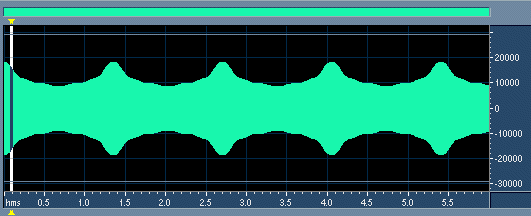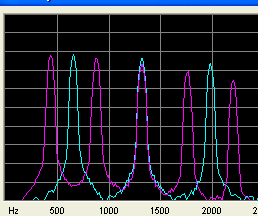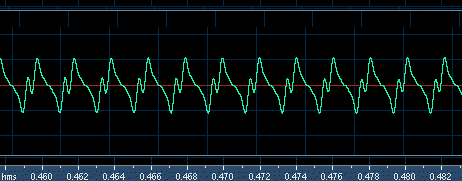Beats
When two tones with a very small frequency difference are played together, a beat tone will be produced. It sounds like whoh-whoh-whoh-whoh-whoh-whoh. The frequency of the beat is equal to the difference in frequency between the two notes.
Listen to the tones 659.26 Hz and 660.00 Hz. (The tempered and the pure E sounding together) You can clearly hear 4 beats on the 6 seconds of the tones, corresponding to the 0.74 Hz difference between the tones.
In the tuning section you may clearly hear the beats in the tempered fifth, when you are listening to the perfect fifth there is no beats!
What is beats
Sound is pressure waves in the air. The higher the frequency the shorter the wave. The waves are all traveling with the same velocity. When two waves have nearly the same frequency the wave crests of the will sometimes add, sometimes subtract.

On the picture above you can see what the maximum amplitude of the joining of the two tones 659.26 Hz and 660 Hz looks like. You can see there is 5 distinct beats in the 6 second sequence. Below we have taken out 10 milliseconds and you can see the wave movement by clicking on the link.
Start animation | Slower | Slowly | Fast | Step | Listen to the two tones
On the picture sequence you can see the two waves some times amplify each other some times they don't
"Undertones"
When I started playing I could hear the under tones also remember hearing a strong beat in the undertones when I was playing intervals, or when I played in harmony with my teacher. I asked my teacher what it was and he told me that they does not exist. Today I can not hear them, but my friends tell me they can here them and that they are very useful for tuning your violin.
The under tones are created by your ear. When the ear hears a tone it does not only make spectrum analysis it performs a cepstrum analysis as well. Spectrum analysis is finding periodicity in the time signal. Cepstrum analysis (pronounced with an initial K) is looking for peroidicity in the spectrum. The ear is trained to find the root note of a harmonic sequence. ( In this way you can hear the base in the radio even if the base is played at a low frequency that is not audible through your radio loudspeaker. The ear hears the harmonic series of the base, and presumes that the root note is there.)
When two tones are played together the ear will see a harmonic series of the difference between the two tones.

Spectrum of a A=440Hz and the perfect fifth E=660Hz. We have seen that
the harmonics coincides on 3*440=2*660=1320Hz Furthermore you see that
the two tones forms a harmonic series of 220Hz The root note (220hz) is
missing, but the ear may add it as an undertone.
The spectrum contains 2. 3. 4. 6. 8. and 9 harmonic of 220 Hz. Note that 5. and 7. harmonic is missing.
